



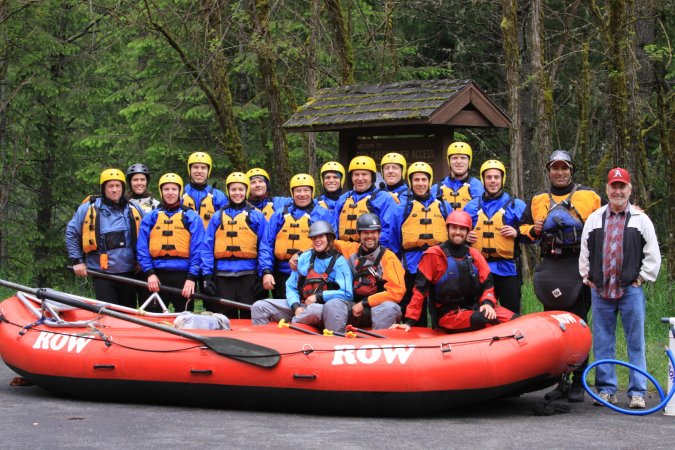
Class
Class III-IV+ rapidsMeeting Point
River Dance Lodge, Syringa, ID8 am PT
Duration
Full DayMeals
Lunch IncludedMinimum Age
17The Super-Lochsa River Rafting
The Super Lochsa day trip is designed for those who have done the Lochsa before, don't have time for our two-day trip, and want the best of the two-day trip squeezed into a single day. It's 30 miles of intense whitewater for the fit and experienced rafter. No other river in the US offers this much excitement packed into one day! When water levels are ideal, we start our trip at Milepost 138 on the river and end around Milepost 107. We paddle our way through rapids like Stanley Creek, Triple Hole, Castle Creek, and many more. The morning is both big and technical while the afternoon run has the biggest hits including the Grim Reaper, Bloody Mary, and Lochsa Falls. When the water is either too high or too low, we do a "double dip" on the lower section, running the same 15 miles twice.
All trips include a fantastic and bountiful lunch on the river's banks. We provide everything you need for this day of action and fun.
The Super Lochsa trip requires a group of 10 or more.
Rates
May 16- June 28, 2026*
*Please note we require a minimum of 10 guests to run a trip. If you have less than 10 in your party, you can still reserve spaces and we will work to place you with another group in order to confirm your trip.
*Dates are subject to change due to water levels and availability.
Prices plus 8% Land & Water Access fee
Itinerary
Starting at 8:00 am PT
Our outpost is located at River Dance Lodge in Syringa, ID. If you plan to fly, the closest airport is in Lewiston, Idaho about two hours away. The closest major airports are Missoula, MT (about 2.5 hours) and Spokane, WA (about 4.5 hours). At the airport, you will need to rent a car to drive to the Lochsa.
*Dates are subject to change due to water levels and availability.
*Must have Previous Class IV experience.
Trip Details
The Super Lochsa day trip is designed for those who have done the Lochsa before, don't have time for our two-day trip, and want the best of the two-day trip squeezed into a single day.
LOCHSA GEAR LIST
Packing properly for a river trip is CRITICAL to your enjoyment while on the river. Although ROW supplies all of your essential gear, there are certain extras that will increase your comfort. We want you to be comfortable and secure so that you can fully enjoy your Lochsa experience.
The weather on the Lochsa is completely unpredictable. It can be rainy and/or cold in May and in early June. In late June and July, the weather is warmer and dryer, although you must come prepared for cold weather. The following information will help you be prepared for the expected, as well as the unexpected events of your trip. You may not use all of the gear listed below, but we recommend bringing it all! If it's a hot day, you can remove some layers.
GEAR PROVIDED BY ROW
- Farmer John style neoprene wet suit
- Long-sleeve neoprene zip-up jacket
- Neoprene Booties
- Fleece Sweater (synthetic nylon pile)
- Paddle/Splash Jacket (similar to a light raincoat)
- Helmet
- Personal Flotation Device
CLOTHES & GEAR FOR THE RIVER (Recommended)
- Swimsuit to wear under wet suit
- Hat to wear under helmet
- Polypropylene or silk long underwear (top and bottom) when it is cold
- Shorts or swim trunks to wear over wet suit
- Wool or polypro socks to wear under booties (ski socks work well)
- Wet suit or wool gloves (optional)
- Sunglasses with "Chums" style eyeglass holder
- Sunscreen
- Water bottle (A cheap solution is to buy bottled water for the day)
- Bee Sting kit (ROW does not carry epinephrine)
- If you have size 13+ feet, bring a pair of old tennis shoes and good wool socks to wear on river
- Towel/change of clothes for end of day (keep these in your vehicle)
We will have one waterproof bag per boat for use to hold a spare warm clothes item, sunscreen, etc. Keep this with you and give it to your guide before boarding your boat. It’s best to only bring a disposable, waterproof camera for use on the river. We have these for sale at our store.
Remember: Cotton is a non-water-wicking material and should never be worn on the river. Cotton holds water against you and makes it difficult to stay warm. Fleece, Pile, Polypropylene, bunting, Capilene, etc., are a few examples of the trade names for a class of synthetic materials that retain their ability to insulate when wet.
Meeting Location
River Dance Lodge, Syringa, ID
Please note River Dance Lodge is just our meeting location. The Lodge is closed and not accepting reservations.
Weather
Click here to view the National Weather Service's forecast for Syringa, Idaho.
Physical Requirements
Here at ROW Adventures, our first and foremost goal is for you to have an enjoyable and safe experience. While most of our trips are suitable for beginners, some of our trips are more active than others and it’s important that you understand the physical requirement of the trip you choose.
All of our rafting trips are active adventures that involve some level of physical exertion and possible exposure to the elements including but not limited to wind, rain, heat, sun, cold temperatures, and cold water conditions. ROW Adventures is able to accommodate people with physical limitations, disabilities, and medical conditions; please speak with your Adventure Consultant if you think you will require any additional assistance while on the trip. We ask that you consult your doctor if you have health or medical conditions that could impact your ability to participate in an active and outdoor adventure. In general, all trip participants must be able to do the following:
- Wear all protective and safety equipment that is required by ROW Adventures and recommended/required by industry-wide standards.
- Load and unload, on their own or with the aid of a qualified companion, the bus and/or van providing transportation for ROW Adventures activities.
- Reach the river access points (put-in and take-out) on their own, or with the aid of a qualified companion.
- Enter and exit the raft, kayak, and/or inflatable kayak on their own or with the aid of a qualified companion.
- Remain seated and balanced in a floating raft, canoe, kayak, or inflatable kayak with the aid of adaptive equipment, if necessary.
- Perform all on-water activities, including following instructions like paddling commands from the guide in class I and higher whitewater on their own or with the assistance of a qualified companion.
- Float on their back when entering moving and still water. The participant must be capable of turning from face-down to face-up in the water with the aid of a Personal Floatation Device and must be able to hold their breath while underwater.
- Remain calm and keep breathing under control in the event of a whitewater swim.
- Get out from under a raft, whether the raft is upright or capsized, in moving water.
- Climb into the raft, with the help of another person, should an involuntary swim happen at any point on the river.
- Make progress toward the shoreline or a raft by swimming in moving water and must be able to exit the river and ascend the shoreline once reached.
- Participate as an active paddler when instructed by the guide for the duration of the trip.
- Move about the campsite on their own or with the aid of a qualified companion on all trips that include overnight camping and/or lunch.
Click HERE to see Terms and Conditions.
Important Notice: ROW has an excellent safety record, but you should know that whitewater rafting is
inherently risky. You will be required to sign a "Release and Assumption of Risk" agreement prior to the trip,
recognizing and accepting the risks involved. If you're interested in trip cancellation, travel, or accident
insurance, contact our office. We do not allow alcoholic beverages or any drugs.
FAQ's
I've never been rafting before. Is the Lochsa an appropriate choice?
Probably not. We prefer people with previous rafting experience on the Lochsa. Of all the rivers where we run 1-day trips, the chances of falling out of a raft are higher on the Lochsa than any other river. We want your first rafting experience to be a positive one. If you fall out and find out that you're terrified, you may not want to go rafting ever again. It's better to gain experience on an easier river where you're more likely to stay in the raft all day! Here's another way to think of it. Say you have never tasted wine in your life. Someone pours you a 20-year-old French Bordeaux. With no point of comparison, the excellence of this wine would likely not be appreciated. Think of the Lochsa as the French Bordeaux. Better to learn more about whitewater on other rivers so you truly appreciate the Class IV power and excitement of the Lochsa's rapids.
Can I go rafting if I don't swim?
Generally yes. Everyone wears a Personal Flotation Device (PFD) and this is a more important tool than knowing how to swim. However, often people who swim are more comfortable in the water and the idea of falling out of a raft. Your best choices would be an easier river like the St. Joe or Clark Fork Rivers.
Is rafting safe?
We've taken tens of thousands of people on our trips lasting from 1 to 6 days over the past 40+ years. We do our best to mitigate the natural risks of rafting. However, we are human and nature can create difficult conditions. People fall out of rafts, rafts can turn over, and people can accidentally hit another person in the raft with a paddle. In the end, however, outdoor adventures such as rafting are inherently risky, thus accidents can and do happen.
What is the most exciting 1-day trip you offer?
Rivers are rated by the difficulty of their rapids, with Class I-II being easier than Class III (Intermediate) or Class IV (advanced). However, bear in mind that the "most exciting" trip may not be the one appropriate for you. Previous rafting experience, water temperature, and the age of those in your party determine which trips are appropriate for you. To help you decide, here's a list of rivers along with their season, water temperature, and rapid classification from easiest to most difficult. (To learn more about rapid classifications, visit our Understanding Whitewater Classifications blog)
Clark Fork River- Class II-III with warmer (62-68 degrees) temperatures in July and August
St. Joe River- Class III-III+ cold (50-60 degrees) water in May/June
Lochsa River- Class IV - IV+ cold (45 degrees) water in May/early June and cool (55-63 degrees) in late June/early July
Do I need experience to raft the Lochsa river?
The Lochsa is considered one of the premier class IV rivers in the United States. We recommend that people have previous whitewater rafting experience on at least class III rivers before running the Lochsa (see our whitewater classification guide for more information on river classifications). You will enjoy your time on the river more if you have had previous experience that gives you an idea of what to expect. Note that at higher water flows the minimum age requirement is 17 and at medium to lower flows it is 14-16 years old upon approval. We reserve the right to refuse to take anyone that we think is an unreasonable risk.
What are the characteristics of the Lochsa?
The Lochsa is a unique river because it offers both a steep gradient dropping 20-40 feet per mile, and at certain times, a fairly large volume of water. Ideal flows for running the river are from about 2,500 to 14,000 cfs (Cubic Feet Per Second). However, we run the river as high as around 18,000 cfs and as low as around 1,200 cfs. At medium to higher flows, more rocks are covered and the waves tend to be bigger with more punch. At medium-low to low flows, there are more rocks to avoid and the technical nature of the river is more challenging. It’s an ever-changing and living river and we recommend you come to experience it at various water levels to understand how magnificent the Lochsa really is! Few other rivers offer so much continuous whitewater!
When is the best time to raft the Lochsa?
This depends on what you’re looking for. Because the Lochsa is a free-flowing river flows depend on air temperature, how much snow is in the mountains, whether it’s raining or not, and many other variables. We sometimes have to cancel trips or substitute another section of the river if the Lochsa gets too high.
Generally, the highest water is from May 25th to June 5th. Our favorite time is from about June 8 to June 30 when the weather is generally warmer and so is the water! Medium to lower flows make for a very exciting whitewater trip on the Lochsa.
What is the water temperature on the Lochsa?
During May and the first couple weeks of June water temperatures vary from about 50-58 degrees Fahrenheit. From mid-June until we stop running in July, the water warms up based on how many hot sunny days there are. By early July it can be in the low 60’s.
How long is the Lochsa season?
The Lochsa is a free-flowing river and water levels are dependent on snowpack in the mountains. Some years there is more snow than others. We usually start around Mother’s Day in May and go until around July 8th. Contact our office for this year’s conditions.


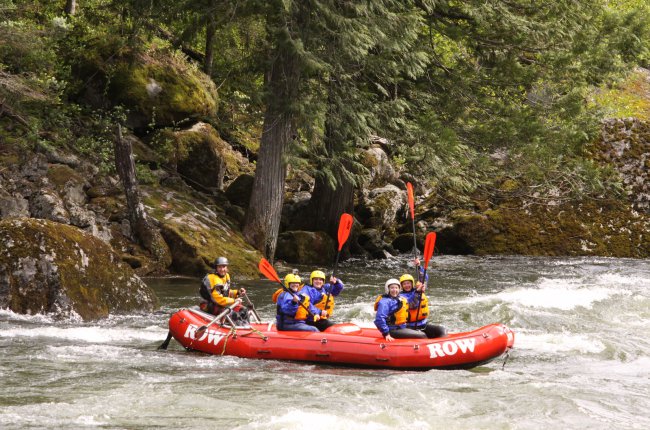
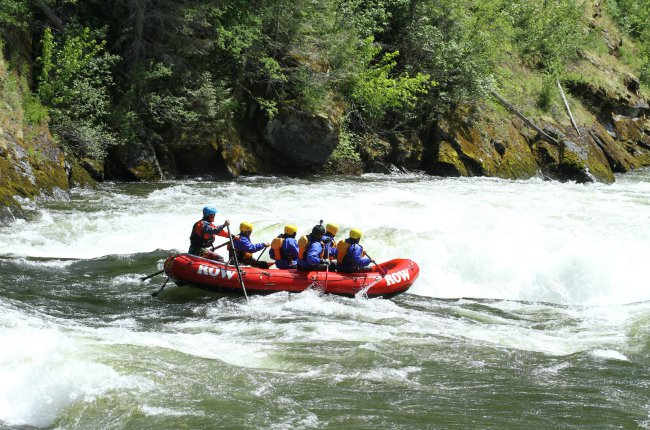
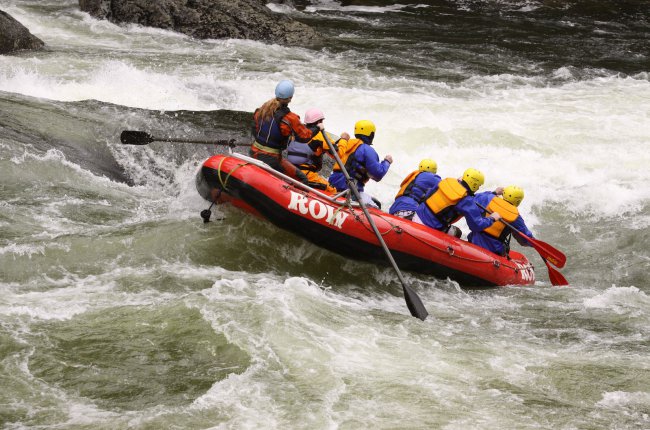

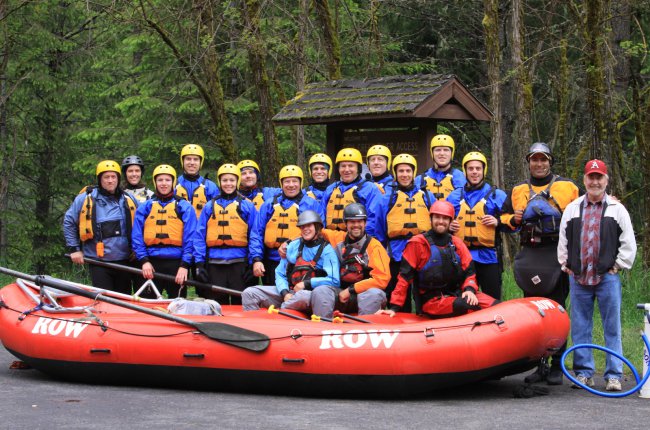
Reviews 5
Overall Rating
Trip of a lifetime and worth every penny!!
Very Exciting Trip Down the Lochsa
A1 experience all round
Great family trip down the Lochsa River!
All in All a Great Experience